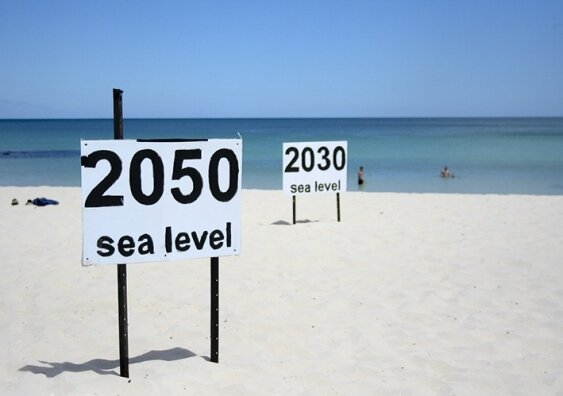
The IPCC says that sea levels can rise by about 30-60 cm by 2100, even if greenhouse gas emissions are drastically reduced and global warming is limited to well below 2 ° C, but about 60- 110 cm if greenhouse gas emissions continue to increase strongly. Credit: go_greener_oz, licensed under CC BY-ND 2.0
Projections of rising sea levels in this century are profitable when tested against satellite and tidal observations, the scientists found.
The projections of the climate model of sea level rises in the early 21st century are in line with sea level data recorded in the corresponding period, a recent analysis concluded.
And the scientists who analyzed the numbers say the discovery does not bode well for impacts at sea level in the coming decades if greenhouse gas emissions are not controlled.
In an article recently published in Nature Communications, scientists from Chinese and Australian institutions, including UNSW Sydney, examined global and regional sea level projections from two reports by the Intergovernmental Panel on Climate Change: the Fifth Assessment Report (AR5) and the Special Report on the Ocean and Cryosphere in a Changing Climate (SROCC).
They compared the projections in the reports with observed global and coastal sea level data, collected from satellites and a network of 177 tide gauges, from the beginning of the projections in 2007 to 2018. Scientists found that the AR5 and SROCC trends Sea level projections in three different greenhouse gas emission scenarios “agree well with satellite and tide observations during the common period 2007-2018, within the 90 percent confidence level.”
The study’s co-author and leading sea level expert, Professor John Church, says that although he thought modeling projections would be accurate at the global level, he was pleasantly surprised that they were so accurate at the regional and local level.
“Our analysis implies that the models are close to the observations and increases confidence in the current projections for the coming decades”, said Prof. Church, which is part of the UNSW Climate Change Research Center.
But he adds a caveat that, as the comparison period available is short, just 11 years, he would hesitate to extend the same degree of confidence in the long term – from the end of this century and beyond – where the acceleration of the mantle of ice contribution to sea level rise is less understood and can lead to greater increases.
“There is still a potential for further sea level increases, particularly beyond 2100 for high emission scenarios. Therefore, it is urgent that we still try to fulfill the Paris Agreement commitments by significantly reducing emissions, ”said Prof. Church.
The study’s co-author, Dr. Xuebin Zhang, of the Oceans and Atmosphere Division of CSIRO, says this is the first study to compare projections of sea level rises at the global and regional level with observations on their overlapping periods – not easy, given the natural variability of climate and vertical movement of the land from region to region.
“We carefully removed the impacts of natural climate variability, for example El Niño – South Oscillation, and corrected the vertical movement of the earth, which led to a much better deal.”
The analysis examined the three different emissions scenarios in the IPCC reports that corresponded to three different climate futures, depending on which greenhouse gas mitigation strategies were adopted – known as representative concentration path (RCP) scenarios.
The lowest scenario (RCP2.6) examined is for strong mitigation of greenhouse gas emissions, almost in line with 2oC of global warming by 2100, but even higher than necessary to meet the Paris Agreement well below 2oC.
The intermediate scenario (RCP4.5) requires the stabilization of radiative forcing in the second half of this century and results in a warming well above the Paris target.
And the highest scenario (RCP8.5) is for large emissions of greenhouse gases, resulting in rapid continuous heating and implies a commitment to large increases in sea level.
“Analysis of recent sea level data indicates that the world is moving between RCP4.5 and the worst scenario of RCP8.5,” said Professor Church.
“If we continue with large continuous emissions as we are today, we will commit the world to raising sea levels in the coming centuries.”
The group will then try to gain a better understanding of the processes that determine sea level rise in the region.
South of France to sizzle due to climate change
Jinping Wang et al. Reconcile the global average and the change in regional sea level in projections and observations, Nature Communications (2021). DOI: 10.1038 / s41467-021-21265-6
Provided by University of New South Wales
Quote: Sea level data confirm that the projections of the climate models were correct (2021, February 15), recovered on February 15, 2021 at https://phys.org/news/2021-02-sea-climate. html
This document is subject to copyright. In addition to any fair dealing for the purpose of study or private research, no part may be reproduced without written permission. The content is provided for informational purposes only.
